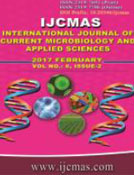


 National Academy of Agricultural Sciences (NAAS)
National Academy of Agricultural Sciences (NAAS)

|
PRINT ISSN : 2319-7692
Online ISSN : 2319-7706 Issues : 12 per year Publisher : Excellent Publishers Email : editorijcmas@gmail.com / submit@ijcmas.com Editor-in-chief: Dr.M.Prakash Index Copernicus ICV 2018: 95.39 NAAS RATING 2020: 5.38 |
Field experiment was conducted at Agricultural College and Research Institute, Killikulam, Tamilnadu during October, 2014 to February, 2015 to study the effect of rice residue management options on soil microbial population and straw decomposition rate under combine harvested rice field. The experiment was laid out in Randomized Block Design and replicated thrice. The treatments comprised rice residue with and without additives [25 kg additional N ha-1 as basal, bio-mineralizer (2 kg t-1 rice residue), cow dung slurry (5%)]. The additives applied individually, in combination of two and combined application of all additives in order to find out the effect of additives on soil microbial population and decomposition rate. The various residue management options significantly influenced the soil microbial population and straw decomposition rate at various growth stages of rice crop. Among the different treatments, straw incorporated with 25 kg additional N ha-1 as basal + bio-mineralizer + cow dung slurry (T8) significantly registered the highest population of bacteria (58, 76 and 68 g-1 x 106 at TL, FL and HA), fungi (51, 70 and 59 g-1 x 104 at TL, FL and HA), and actinomycetes (58, 67 and 62 g-1 x 103 at TL, FL and HA) at all stages. In relation to that, highest decomposition rate (C: N ratio: 26.7, 20.3 and 14.4 at TL, FL and HA) also observed in that same treatment (T8). The lowest population of soil bacterial (41, 58 and 49 g-1 x 106 at TL, FL and HA), fungi (26, 43 and 22 g-1 x 104 at TL, FL and HA) and actinomycetes (34, 49 and 34 g-1 x 103 at TL, FL and HA) observed in treatment (T9), where straw removed (control). The lowest decomposition rate (C: N ratio: 48.6, 35.5 and 19.2 at TL, FL and HA) observed in the treatment (T1), where straw was incorporated without any additives.
 |
 |
 |
 |
 |